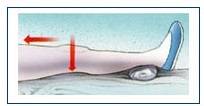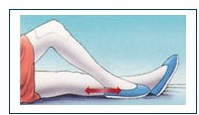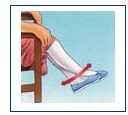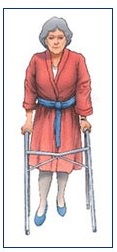Introduction
Total Knee Replacement is a surgical procedure to replace a damaged knee joint with an artificial one.
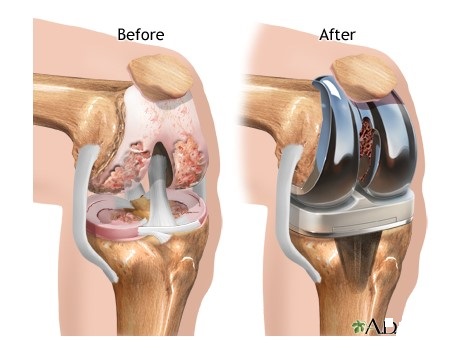 |
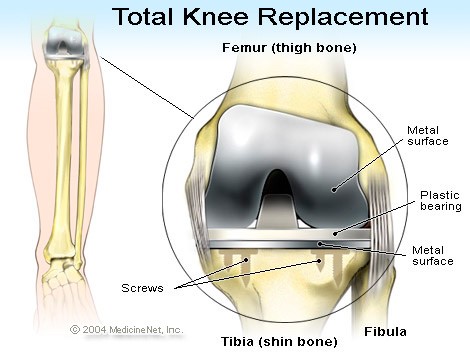 |
(Source: http://www.adameducation.com/ & 2004 MedicineNet. Inc)
A joint replacement is only recommended by your Orthopedic Surgeon when your knee joint is severely damaged causing restriction in your daily activities.
Post Surgery
After Total Knee Replacement surgery, you can expect:-
- Pain at the operated knee
- Difficulty to move without assistance
However this situation is only temporary. Physiotherapy is very important after your surgery. Your Orthopedic Surgeon will refer you to a physiotherapist after your surgery. You need to co-operate and work with your physiotherapist in order to maximize your rehabilitation outcome.
Complications
The following problems may arise if you are not diligent with your exercise therapy :-
- Deep Vein Thrombosis
Blood clot may form in the veins within your calves. This is a harmful condition especially if the clot moves to your lungs.
- Knee Joint Stiffness
When you do not mobilize enough, your prosthetic knee will become stiff. Your compliance to the exercises your physiotherapist teach will ensure a mobile joint.
It is within your control to minimize the risk of you developing post-operative complications mentioned above. Even though you will be in pain, you need to move as early as possible post-operatively. You will be given analgesics to reduce your pain. Move slowly and frequently. Your physiotherapists will be there to assist and guide you throughout your rehabilitation.
Treatment
1. Physiotherapy in the ward (Immediate post (operative phase) :-
You may start your exercises when you return to your ward after your surgery. You will experience some pain and discomfort initially but exercises will help reduce your post-operative pain.
Start with the following exercises :-
(a) Quadriceps exercise
Tighten the muscles in front of your thigh while trying to straighten your knee. Hold for 5-10 seconds. Repeat 10 times. Do this every waking hour.
|
(b) Circulatory exercise
|
Move your foot up and down for 2-3 minutes. Repeat every waking hour.
Do continue this exercise until all the swelling around your lower leg and ankle subsides. |
|
(c) Knee straightening exercise
|
Roll a towel and place it under your heel.
Tighten your thigh muscles while trying to straighten your knee fully. Hold for 5-10 seconds. Repeat 10 times. Do this every waking hour. |
|
(d) Knee bending exercise
|
You need to mobilize your knee as soon as possible.
Slowly bend your knee while sliding your heel on the bed. Keep your knee bent for 5-10 seconds, and then straighten it fully. Repeat 20 times. Do this every waking hour. |
Usually your physiotherapist will assist you into sitting the next day after your surgery. You will then start your exercises while sitting and you may be taught to walk using a walking aid.
|
( e) Exercise while sitting
|
You can do this exercise sitting over the edge of your bed or sitting in a chair. Support your painful leg with the good one. Slowly bend your knee as much as you can. Hold for 5-10 seconds. Repeat 10 times or till you achieve 90o bending.
|
|
(f) Walking
|
You will be taught how to walk using a walking aid when your surgeon permits. Later when your condition improves it, your physiotherapist will help you to walk as normal as possible |
2. Physiotherapy after discharge from the ward (advance exercises)
Following discharge from the ward, you will still need to return to the hospital as outpatient for your rehabilitation. This is to ensure maximum recovery and return to your activities. You are to undergo progressive strength and balance training. Optimum recovery may take months. You are strongly advised to see a physiotherapist at the nearest hospital.
Success of a knee joint replacement partly depends on your commitment during the rehabilitation phase. Be sure to comply with your exercise program. If you have any problem doing so, communicate with your physiotherapist so that an alternative can be worked out.
Reference
- http://orthoinfo.aaos.org
- http://www.medicinenet.com/total_knee_replacement
- http://www.mayoclinic.org/tests-procedures/knee-replacement/
| Last Reviewed | : | 23 August 2019 |
| Writer / Translator | : | Nurul Liyana Teong |
| Accreditor | : | Daaljit Singh a/l Harbachan Singh |
| Reviewer | : | Halimah bt. Hashim |



